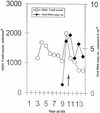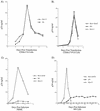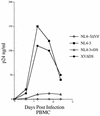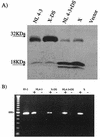Inhibition of human immunodeficiency virus type 1 (HIV-1) replication by a two-amino-acid insertion in HIV-1 Vif from a nonprogressing mother and child
- PMID: 12239333
- PMCID: PMC136583
- DOI: 10.1128/jvi.76.20.10533-10539.2002
Inhibition of human immunodeficiency virus type 1 (HIV-1) replication by a two-amino-acid insertion in HIV-1 Vif from a nonprogressing mother and child
Abstract
We studied a 15-year-old girl, patient X, who has maintained consistently low plasma loads of human immunodeficiency virus type 1 (HIV-1) RNA, as well as normal and stable CD4(+) T-cell concentrations. She has presented no clinical manifestations of AIDS, despite having only received zidovudine monotherapy for a part of her life. Patient X's HIV-positive mother (patient Y) has also not progressed to AIDS and has never been treated with antiretroviral agents. HIV-1 isolated from patient X replicated poorly in human peripheral blood mononuclear cells (PBMC). In order to map the determinant of the poor growth of patient X's isolate, viral sequences from patient X were determined and examined for insertion or deletion mutations. These sequences contained a two-amino-acid insertion mutation in the Vif gene, which was also observed in uncultured PBMC acquired at different times. Furthermore, Vif sequences harbored by patient Y contained the identical mutation. These observations suggest that polymorphic HIV-1 was transmitted to patient X perinatally 15 years previously and has been maintained since that time. Recombinant HIV-1, engineered with Vif sequences from patient X, replicated in PBMC to levels approximately 20-fold lower than that of wild type. Removal of the insertion mutation from this recombinant restored replication efficiency to wild-type levels, while introduction of the insertion mutation into wild-type Vif sequences resulted in greatly decreased replication. Furthermore, Vif protein from patient X's HIV-1 was aberrantly cleaved, suggesting a mechanism for loss of Vif function. Since HIV-1 containing these sequences replicates poorly, the implication is that the two-amino-acid insertion mutation in Vif contributes significantly to the nonprogressor status of this mother and child. Further studies of these sequences might provide information regarding contributions of Vif structure and/or function to HIV-1 virulence.
Figures





References
-
- Alexander, L., E. Weiskopf, T. C. Greenough, N. C. Gaddis, M. R. Auerbach, M. H. Malim, S. J. O'Brien, B. D. Walker, J. L. Sullivan, and R. C. Desrosiers. 2000. Unusual polymorphisms in human immunodeficiency virus type 1 associated with nonprogressive infection. J. Virol. 74:4361-4376. - PMC - PubMed
-
- Aquino-De Jesus, M. J., C. Anders, G. Miller, J. W. Sleasman, M. M. Goodenow, and W. A. Andiman. 2000. Genetically and epidemiologically related “non-syncytium-inducing” isolates of HIV-1 display heterogeneous growth patterns in macrophages. J. Med. Virol. 61:171-180. - PubMed
-
- Binley, J. M., X. Jin, Y. Huang, L. Zhang, Y. Cao, D. D. Ho, and J. P. Moore. 1998. Persistent antibody responses but declining cytotoxic T-lymphocyte responses to multiple human immunodeficiency virus type 1 antigens in a long-term nonprogressing individual with a defective p17 proviral sequence and no detectable viral RNA expression. J. Virol. 72:3472-3474. - PMC - PubMed
Publication types
MeSH terms
Substances
Associated data
- Actions
Grants and funding
LinkOut - more resources
Full Text Sources
Medical
Molecular Biology Databases
Research Materials

